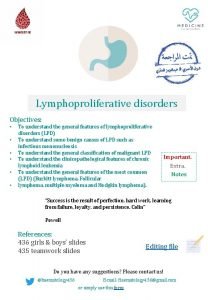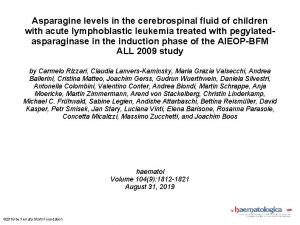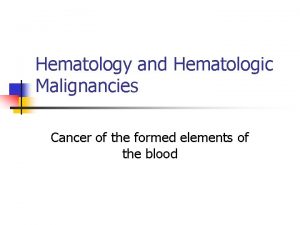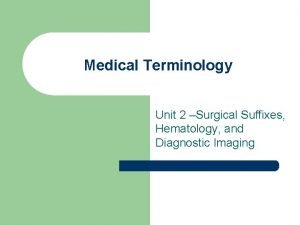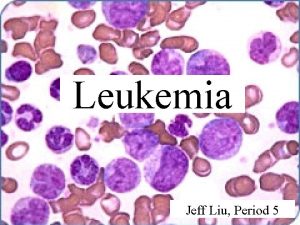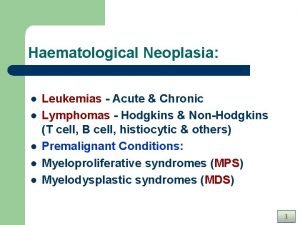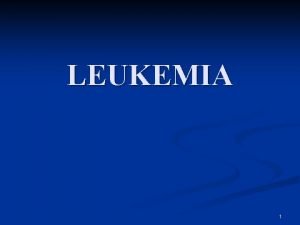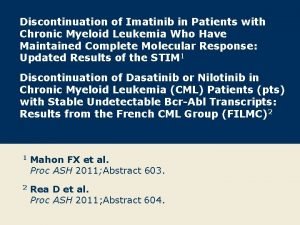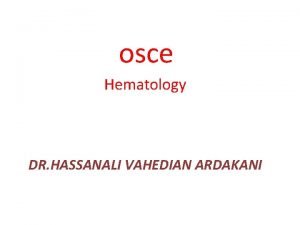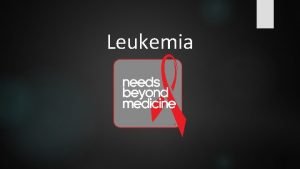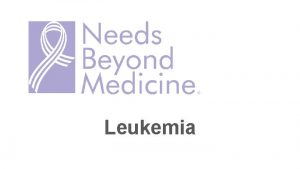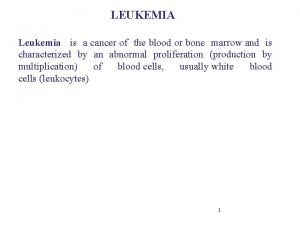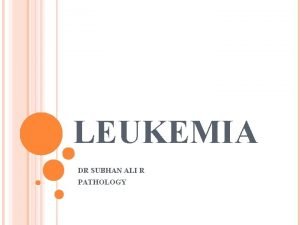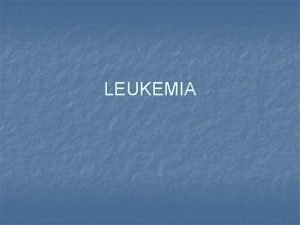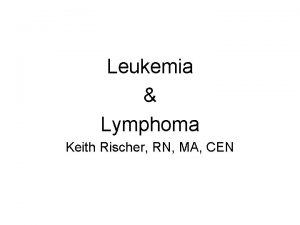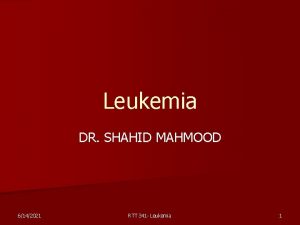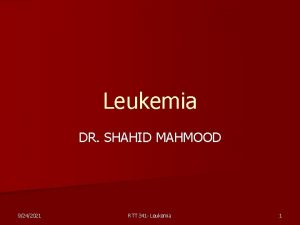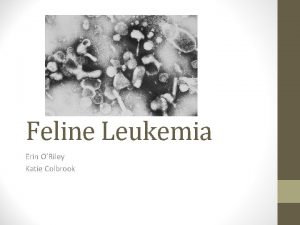Leukemia What is Leukemia Leukemia is a cancer



















- Slides: 19

Leukemia

What is Leukemia? ▶ Leukemia is a cancer of the blood ▶ It is the most common type of blood cancer beginning in the bone marrow where abnormal white blood cells are produced

Leukemia Statistics ▶ There an estimated 363, 794 people living with, or in remission from, leukemia in the US. ▶ In 2018, 62, 130 people are expected to be diagnosed with leukemia. ▶ In 2007 -2011, leukemia was the fifth most common cause of cancer deaths in men and the sixth most common in women in the US.

Types of Leukemia Five types of Leukemia ▶ Chronic Lymphocytic Leukemia ▶ Acute Myeloid Leukemia ▶ Chronic Myelomonocytic Leukemia ▶ Chronic Myeloid Leukemia

Chronic Lymphocytic Leukemia ▶ Builds slowly over time, usually asymptomatic for a few years ▶ Can eventually spread to the lymph nodes, liver, and spleen ▶ Accounts for ⅓ of all Leukemias ▶ Approximately 20, 940 new cases last year ▶ Affects mainly older adults, usually over the age of 70

Acute Lymphocytic Leukemia ▶ More common in children than in adults ▶ Approximately 5, 960 new cases in 2017 ▶ Starts with immature white blood cells ▶ Rapid onset

Acute Myeloid Leukemia Approximately 19, 520 new cases in 2017

Chronic Myelomonocytic Leukemia

Chronic Myeloid Leukemia

Risk Factors ▶ Very high levels of radiation ▶ Working with certain Chemicals ▶ Chemotherapy ▶ Down Syndrome and other genetic disorders ▶ Human T-cell leukemia virus-I (HTLV-I) ▶ Myelodysplastic syndrome


Tests and Exams for Leukemia If your doctor suspects leukemia, he or she may: • Ask about your medical history. • Check for enlarged lymph nodes in your neck, underarm, or groin. • Check for an enlarged liver or spleen. • Do a complete blood count (CBC) and a blood chemistry. These tests let your doctor look into symptoms such as fatigue, weakness, fever, bruising, or weight loss. • Do a bone marrow aspiration and biopsy. This is the key to diagnosing most leukemias and helps determine the type.

Tests for the Type of Leukemia ▶ A blood test is usually enough to find signs of chronic lymphocytic leukemia (CLL). ▶ Tests that look closely at unusual cells, chromosomes, or proteins on cells can show what type or subtype of leukemia you have. These tests include: ● cytogenetic analysis ● immunophenotyping ● reverse transcription-polymerase chain reaction test or RT-PCR ▶ Chest X-rays, to find out if leukemia or an infection is the cause of lung problems such as persistent coughing, coughing up blood, chest pain, or trouble breathing. ▶ CT scan of the head, chest, and belly, to find out if leukemia has spread there. ▶ Lumbar puncture, to find out if leukemia cells are in your cerebrospinal fluid (CSF). ▶ MRI of the brain, to look into symptoms such as confusion, paralysis, numbness, vision problems, vertigo, or headaches. Those symptoms could mean that leukemia has spread to the brain. ▶ A biopsy of a lymph node or other tissues, to look for leukemia cells.

Treatment for Leukemia 1. chemotherapy to kill leukemia cells using strong anti-cancer drugs 2. interferon therapy to slow the reproduction of leukemia cells and promote the immune system's antileukemia activity 3. radiation therapy to kill cancer cells by exposure to high-energy radiation 4. stem cell transplantation (SCT) to enable treatment with high doses of chemotherapy and radiation therapy 5. surgery to remove an enlarged spleen or to install a venous access device (large plastic tube) to give medications and withdraw blood samples

Treatment for Leukemia Most treatment plans for acute lymphoblastic leukemia (ALL) have 3 steps. These are induction, consolidation, and maintenance. ▶ Induction therapy kills leukemia cells in the blood and bone marrow to induce remission. Treatments include chemotherapy and corticosteroids. ▶ Consolidation therapy kills any leukemia cells that may be present even though they don't show up in tests. If these cells regrow, they could cause a relapse. Treatments include more chemotherapy and may include stem cell transplant. ▶ Maintenance therapy also prevents any remaining leukemia cells from growing. This may be done using lower doses of chemotherapy than those used during induction or consolidation. When there are no signs of leukemia for 5 years, a person is usually considered cured. But if the leukemia doesn't go into remission, or if it comes back within the first few years, treatments may include more chemotherapy, a stem cell transplant, or joining a clinical trial for new treatments.

Survival Rates for Leukemia ▶ The overall five-year relative survival rate for leukemia has more than quadrupled since 1960. From 1960 to 1963, the five-year relative survival rate among whites (only data available) with leukemia was 14 percent. From 1975 to 1977, the five-year relative survival rate for the total population with leukemia was 34. 2 percent, and from 2004 to 2010, the overall relative survival rate was 60. 3 percent. ▶ From 2004 -2010, the five-year relative survival rates overall were ▶ CML - 59. 9 percent ▶ CLL - 83. 5 percent ▶ AML - 25. 4 percent overall and 66. 3 percent for children and adolescents younger than 15 years ▶ ALL - 70 percent overall, 91. 8 percent for children and adolescents younger than 15 years, and 93 percent for children younger than 5 years.

Follow Us!!! @Needs. Beyond. Med ▶ Twitter ▶ Facebook ▶ Instagram ▶ You. Tube ▶ Google+

Questions

References http: //nihseniorhealth. gov/leukemia/whatisleukemia/01. html https: //www. lls. org/facts-and-statistics-overview http: //www. cancercompass. com/leukemia-information/causes-and-risk-factors. htm http: //www. webmd. com/cancer/tc/leukemia-symptoms http: //www. webmd. com/cancer/tc/leukemia-exams-and-tests http: //rlv. zcache. com/common_symptoms_chart_of_leukemia_blood_cancer_poster-r 58 cfefb 59544479895 fbf 90 d 54190837_azmyd_8 byvr_1024. jpg http: //www. webmd. com/cancer/tc/leukemia-treatment-overview http: //www. healthcommunities. com/leukemia/treatment. shtml http: //image. slidesharecdn. com/leukemia-rolland-130818212948 -phpapp 01/95/leukemia-causes-symptoms-types-diagnosis-and-treatment-33638. jpg? cb=1426030113 http: //healthhubs. net/images/survival-leukemia-type. gif https: //www. lls. org/facts-and-statistics-overview
 Conclusion differentiation
Conclusion differentiation Leukemia
Leukemia Asparagine
Asparagine What is the difference between lymphoma and leukemia
What is the difference between lymphoma and leukemia Hairy cell leukemia
Hairy cell leukemia Leukemia survival rate
Leukemia survival rate Tomy a suffix denoting an incision
Tomy a suffix denoting an incision Leukemia
Leukemia Acute mylogenous leukemia
Acute mylogenous leukemia Mark juckett md
Mark juckett md Clinicaloptions
Clinicaloptions Lll leukemia
Lll leukemia Trombopoetik adalah
Trombopoetik adalah Chronic myeloid leukemia
Chronic myeloid leukemia Leukemia statics
Leukemia statics The suffix scope indicates a/an
The suffix scope indicates a/an Myelobast
Myelobast Principle of pas stain
Principle of pas stain Funkcie krvi
Funkcie krvi Promyelocytic
Promyelocytic

